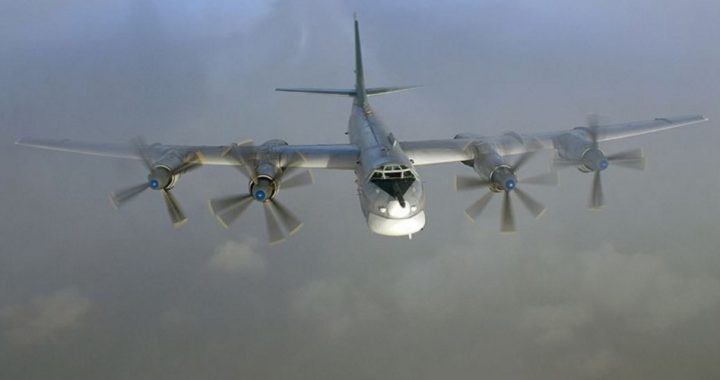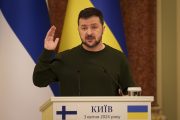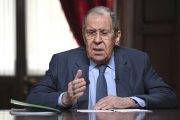
On May 6, Russia received its first shipment of Sukhoi Su-34 twin-seat fighter-bombers (known by NATO as “Fullback”). The Su-34 is the newest generation of fighter-bombers intended to replace the outdated Soviet-era Sukhoi Su-24s.
While the modernization of the Russian Air Force may — and rightfully so — raise a few eyebrows of concern, this alone is not sufficient cause for alarm. Russia’s recent air force maneuvers are, however.
On the night of March 29, 2013, two Russian Tupolev Tu-22M3 bombers (known by NATO as “Backfires”), escorted by four Russian Sukhoi Su-27 fighters (known by NATO as “Flankers”) passed extremely close to Swedish airspace and simulated an aerial “attack” on Stockholm and southern Sweden. The Tu-22M3 is a new supersonic long-range bomber capable of delivering nuclear weapons to overseas targets.
The six Russian aircraft flew dangerously close to Swedish airspace, roughly 20 miles from Sweden’s territorial borders, according to Business Insider.
While Russian military aircraft flying over the Baltic has become routine since Russian President Vladimir Putin restored the old Soviet-era long-range strategic flights in 2011, what makes this particular flight so concerning was Sweden’s lack of readiness. The Swedish Air Force was caught off guard and failed to respond.
The flights occurred on Good Friday at around 2 a.m. local time. Business Insider reported that “at least two JAS-39 Gripen should always be in a QRA (Quick Reaction Alert) and ready for take off in case of alarm, but quite surprisingly there were no interceptors ready on Good Friday night.”
Instead of Swedish fighters, two Danish F-16 fighter jets under NATO command intercepted and escorted the Russian planes safely away from Sweden’s borders.
While Sweden may be grateful to Denmark’s Royal Danish Air Force, this raises serious concerns over Sweden’s ability to repel and/or deter aggression against its national borders. This incident also raises concerns over the increased belligerence on the part of Russia.
Massive military reductions to the Swedish Armed Forces may account for the air force’s lack of readiness. During the 1980s, the Swedish Air Force was comprised of 20 squadrons and over 400 planes. Today, it posseses no more than four squadrons and less than 150 planes. Meanwhile Russia increased its military spending 16 percent in 2012, primarily on new weapons systems and the modernization of outdated military hardware.
A month later, on the night of April 28, two Russian Tupolev Tu-95 (known by NATO as “Bear-H”; shown, above) long-range heavy nuclear bombers “were detected flying into the military’s Alaska Air Defense Identification Zone (ADIZ) near the Aleutians, where a strategic missile defense radar is located,” according to the Washington Free Beacon.
Again, the Russian bombers did not penetrate Alaskan or U.S. airspace, but they did fly dangerously close to it, prompting two U.S. F-22 fighter jets to scramble from Elmendorf Air Force Base. Bill Gertz of the Washington Free Beacon writes, “The dispatch of F-22s is an indication the bomber flights posed a potential threat to U.S. territory. It was the fifth incident of Russian strategic bombers flying against the United States since June, when Bear bombers were intercepted near Alaska during a large-scale Russian strategic nuclear exercise that Russian military officials said involved practice strikes against U.S. missile defense sites in Alaska.”
On February 12, two of the same class of Russian Tu-95 Bear-H strategic bombers flew over and encircled Guam. This also prompted a quick U.S. deployment of F-15s to intercept and escort the Russian bombers away from U.S. airspace.
Although Putin announced to the world that Russia would conduct such flights in 2011, two Russian Tu-95 bombers made a round-trip surprise “visit” to Guam in 2007 for the first time since the alleged end of the Cold War.
“Who told you that the Cold War was ever over? It transforms; it is like a virus,” said Russian KGB/FSB defector Sergei Tretyakov in an interview with FOX News in 2009.
In 2007, Russian President Vladimir Putin reiterated the continuation of the Cold War by threatening the West with a “new spiral in the arms race.” In Putin’s KGB eyes the Cold War never ended; it is ongoing. Meanwhile, the West applauds Putin as a close ally on the War on Terror. With allies like Putin are enemies really necessary?




